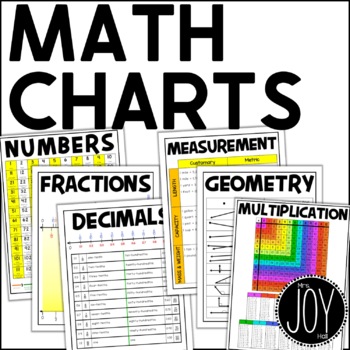Math Charts for Upper Elementary with Fractions, Decimals, Multiplication...
- PDF
What educators are saying
Also included in
- Easy-to-implement differentiated math kits are quick and effective for teaching rules of divisibility, least common multiples, long division, coordinate graphing, decimals, probability, square roots, multi-digit multiplication, and MORE! Use these fifteen engaging math kits to captivate your studentPrice $93.45Original Price $133.50Save $40.05
Description
Differentiated versions of multiplication charts, fraction number lines, geometry vocabulary, prime and composite numbers charts, as well as decimal charts are included in color versions, black & white versions, and partially completed versions. Math reference charts can be the key in making upper elementary math accessible for all students.
The NINE different charts include:
- Numbers - numbers 1-120 with number words and a place value chart
- Prime and Composite Numbers - definitions and number chart
- Multiplication Charts - chart and multiplication problem lists
- Money, Time, and Calendar Charts - coin images, amounts, calendar conversions
- Fractions List - common fractions with visual representation
- Fraction Number Line - common fractions on a number line
- Decimals - number line and fraction conversions
- Measurement Conversions - both US customary and metric measurements
- Geometry Vocabulary - images, vocabulary, and definitions
Tailor your math class by choosing which version your students need. Students who struggle the most will find the colored versions that are fully completed the most useful as a reference tool.
*********************************************************
Did you know that leaving feedback earns you points toward FREE TPT purchases?
*********************************************************
OTHER RESOURCES
- Advanced Long Division Kit
- Beginning Long Division Kit
- Differentiated Least Common Multiples Pack
- Mighty Multiplication eBook – 2 x 1, 2 x 2, etc.
- Perfect Squares and Square Roots Exploration Kit
*********************************************************
CONTACT ME!
Please contact me with any questions. Oh, and I LOVE positive feedback!
Come and visit me at my Teachers Pay Teachers store, my blog, mrsjoyhall.com, and my Facebook page!






